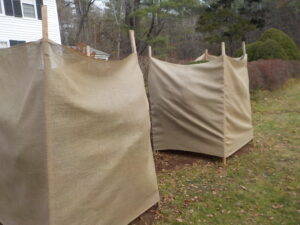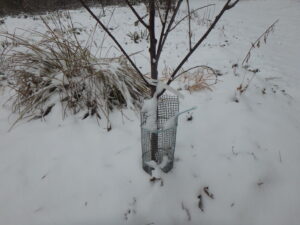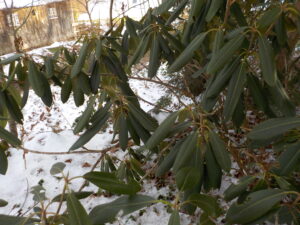Winter Tree Care
Posted on Monday, November 21, 2022 · Leave a Comment
Living in New England is a joy, but we gardeners do have some challenges: cold winter winds, deer, rocky soil and more. As we get ready for winter, one of the biggest challenges for many of us are the deer. They are hungry and relentless. In my part of the world, there was a crop failure for acorns this year, a staple for hungry deer. The deer don’t care that you spent $275 on a nice tree. If they want to browse it, they will … unless you take steps now to protect it.
The most expensive but most sure method to prevent deer from damaging you plants is to fence your entire property with 8-foot tall deer fence. That will keep them from your flowers – tulips are a favorite – as well as vegetables, shrubs and trees. It’s what most arboretums do. You don’t need to have a metal fence – though metal posts are best – as plastic mesh deer fencing is readily available.

Burlap will protect these yews from deer all winter
Alternatively, you can protect plants that have suffered damage in the past, or, if new, are known as “deer candy”. Yew is an evergreen favorite of deer. I recently wrapped a pair of yews with burlap for a client whose plants had suffered deer damage in the past. The plants stand seven feet tall or so, and are about as wide. I used a 6-foot wide roll of 10 oz. burlap to wrap the shrubs and four 8-foot tall stakes for each plant. I left the top open to avoid breakage due to heavy snows. The burlap came from www.burlapsupply.com.
Various repellent sprays may deter the deer, too. But if they wear off before you re-apply, the deer will let you know. Rain and warmer weather can affect how long they last.

Hardware cloth will keep rodents from chewing the bark and killing this young cherry tree.
Voles and other rodents can be a problem, too. Years when we have deep snow are the worst because owls and hawks are less able to eat the rodents that may eat the bark and girdle a tree. Wire mesh known as hardware cloth is great for keeping away rodents, but now plastic spiral wraps are available and easier to install. Young fruit trees are the most vulnerable, so do protect yours until they are 5 years old or so. Protection should go up 18 to 24 inches of the trunk.
What about those evergreen rhododendrons that have their leaves shrivel up? When the ground freezes the roots can’t take up water to replace water used in photosynthesis on sunny days or water that just evaporates from the broad leaves. There is a product called Wilt-Pruf that works as an anti-transpirant for up to four months in winter. It is available in ready-to-use form, or as a concentrate.

Rhododendron leaves often shrivel up in winter but recover in spring.
According to its literature, Wilt-Pruf “contains a film-forming polymer which offers high density, good efficacy, and even coverage across foliage.” Talking with a local arborist, I was advised to spray both top and bottom of leaves or needles, and to do so late in the fall. He also said it may also make foliage less attractive to deer. Shriveled leaves do recover, come spring.
If you planted new trees this year, think about mulching with bark mulch now if you haven’t done so. Trees do much of their root growth now, after leaf drop and before the ground freezes deeply. Trees have stored carbohydrates for use by roots even though they are no longer producing them.
By now I have about an inch of frozen soil on the surface, but roots are deeper than that – most are within a foot of the surface. So you can still put down two inches of mulch over the roots to slow the freezing of the soil.
Although traditionally farmers pruned their apple trees in late winter or early spring, I have always assumed that the reason for this is that they had time on their hands then. But if you want to do some pruning now, after the garden has gone to bed, feel free!
Begin pruning by removing any dead branches. This is a bit trickier now than when leaves are on the tree. Just look for cracked or damaged branches. Dead branches have bark that is a bit different than the rest: dry, flakey, lifeless. Rub small branches with a thumbnail. If you see green beneath the outer layer, the branch is alive. If there is no green, the branch is dead.
The goal of pruning is to allow every leaf to get sunshine. If the density of branches is too great, inner leaves will not do their job. Leaves have two major jobs: to feed sugars to their roots and to help produce flowers, fruit and seeds. If you prune back too much, a tree will respond by growing lots of new shoots, usually those vertical water sprouts. Don’t take off more than 20% of the tree in any one season.
Look for rubbing branches, branches growing towards the center of the tree or branches that parallel others closely. Those are all good candidates for removal. And any time a fruit tree is getting too tall, reduce the height. Finally, pruning should make your tree or shrub beautiful to look at – especially in winter.
Henry is a UNH Master Gardener and a lifelong organic gardener. Reach him at PO Box 364, Cornish Flat, NH 03746 or
henry.homeyer@comcast.net.





